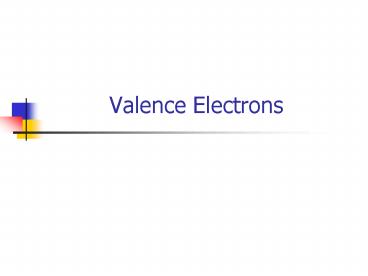Valence Electrons PowerPoint PPT Presentation
Title: Valence Electrons
1
Valence Electrons
2
The Octet Rule
- Atoms are most stable when they have a full shell
of electrons in the outside electron ring,
usually 8.
3
How to determine the valence electrons
- By the group the element belongs to.
4
Group 1 (Alkali Metals) Elements
- Have one electron in the outside shell
- They all have a valence of 1
- Will lose one and only one electron, that single
outside electron to become a single positive ion
with a full electron shell of eight electrons - Lithium Sodium
5
Group 2 (Alkaline Earth) Elements
- Have two electrons in the outer shell
- Have a valence of 2
- Can lose two electrons to become 2 ions
- Beryllium Magnesium
6
Transition Elements, Lanthanides, and Actinides
Metals
- Many of them have varying valences because they
can trade around electrons from the outer shell
to the inner subshells that are not filled. - They sometimes appear to violate the octet rule.
7
Group 3 Elements (Boron)
- Have three outer shell electrons
- Have a valence of 3
- Boron Aluminum
8
Group 4 Elements (Carbon)
- Carbon and silicon are non-metals because it is
difficult to lose the entire four electrons in
the outer shell, therefore they share electrons
covalently - Carbon
9
Group 5 Elements (Nitrogen)
- Nitrogen and phosphorus are non-metals. They
tend to gain three electrons to make an octet or
bond covalently - Nitrogen
10
Group 6 Elements (Oxygen)
- Oxygen and sulfur tend to either gain 2 electrons
or bond covalently. - -2 charge
- Oxygen Sulfur
11
Group 7 Elements (Halogens)
- Have seven electrons in the outer shell
- Can gain one electron to become a 1 ion
- Could make a covalent bond
- Are diatomic gases due to the strong tendency to
bond to each other with a covalent bond. - Fluorine Chlorine
12
Group 8 Elements (Noble gases)
- Have a full octet in the outer shell
- Do not naturally combine chemically with other
elements stable alone! - Helium Neon
13
The Charges of their ions
- Metals positive charges
- Non-Metals negative charges
PowerShow.com is a leading presentation sharing website. It has millions of presentations already uploaded and available with 1,000s more being uploaded by its users every day. Whatever your area of interest, here you’ll be able to find and view presentations you’ll love and possibly download. And, best of all, it is completely free and easy to use.
You might even have a presentation you’d like to share with others. If so, just upload it to PowerShow.com. We’ll convert it to an HTML5 slideshow that includes all the media types you’ve already added: audio, video, music, pictures, animations and transition effects. Then you can share it with your target audience as well as PowerShow.com’s millions of monthly visitors. And, again, it’s all free.
About the Developers
PowerShow.com is brought to you by CrystalGraphics, the award-winning developer and market-leading publisher of rich-media enhancement products for presentations. Our product offerings include millions of PowerPoint templates, diagrams, animated 3D characters and more.

